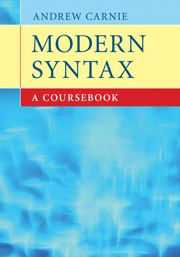Book contents
- Frontmatter
- Contents
- Acknowledgments
- How to use this book
- A note on the theoretical perspective of this book
- 1 Some basic ideas in syntax
- 2 Categories and subcategories
- 3 Constituents, MERGE and trees
- 4 Movement and control
- 5 Conclusions
- Appendix 1 Glossary, symbols and abbreviations
- Appendix 2 Features and their values
- Appendix 3 Rules, constraints and principles
- References
- Index
3 - Constituents, MERGE and trees
Published online by Cambridge University Press: 05 June 2012
- Frontmatter
- Contents
- Acknowledgments
- How to use this book
- A note on the theoretical perspective of this book
- 1 Some basic ideas in syntax
- 2 Categories and subcategories
- 3 Constituents, MERGE and trees
- 4 Movement and control
- 5 Conclusions
- Appendix 1 Glossary, symbols and abbreviations
- Appendix 2 Features and their values
- Appendix 3 Rules, constraints and principles
- References
- Index
Summary
CONSTITUENCY
Objectives:
Understand the definition of constituent.
Explore constituency tests including: standing alone, replacement and displacement.
Start looking at representing these structures in tree format.
Constituents
Definition A constituent is an identifiable subpart of a sentence. It can either be a single word or a group of words that functions as a unit. Most constituents are called phrases. (We'll develop a better definition of “phrase” later.)
Comment In unit 3, looking at evidence from the formation of yes/no questions, we saw that rules like Subject/Auxiliary Inversion make reference to the internal structure of sentences. Constituents are these internal structures. In this unit, we look at how we identify these structures.
Discussion As a first step, we can observe that constituents typically correspond to strings of words that are bound together in terms of semantics. The relevant notion here is vague but hopefully intuitive: modification. If one word modifies the meaning of another, they will be linked together in a constituent. Consider the string the very big can of tuna. Look at the words very and big; notice how there is a close relationship between these. Very modifies big; it tells you how big the can is. Compare this to the relationship between very and can: very does not tell you how can something is! This means that there is a constituent consisting of very and big, but excluding can.
Information
- Type
- Chapter
- Information
- Modern SyntaxA Coursebook, pp. 109 - 228Publisher: Cambridge University PressPrint publication year: 2011
